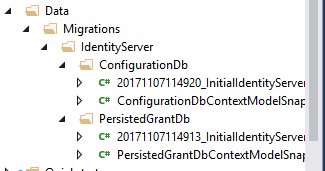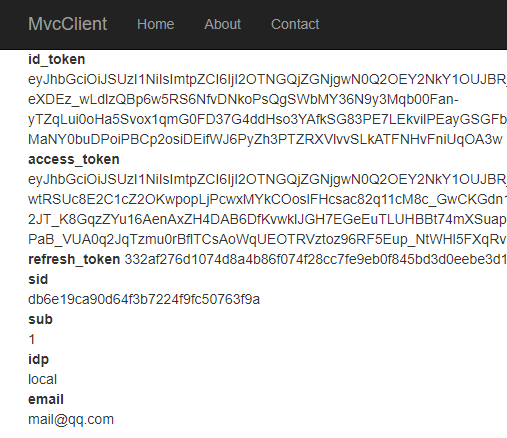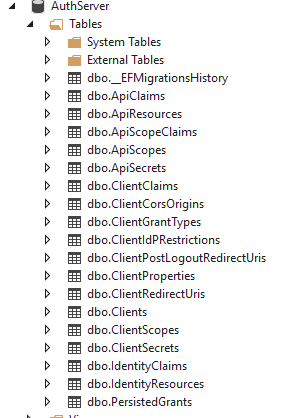使用Identity Server 4建立Authorization Server (5)
预备知识: http://www.cnblogs.com/cgzl/p/7746496.html
第一部分: http://www.cnblogs.com/cgzl/p/7780559.html
第二部分: http://www.cnblogs.com/cgzl/p/7788636.html
第三部分: http://www.cnblogs.com/cgzl/p/7793241.html
第四部分: http://www.cnblogs.com/cgzl/p/7795121.html
之前的配置都是在内存中, 下面将如何把这些数据存储到Sql Server数据库, 这样更适合生产环境.
这部分基本完全参考官方文档:
https://identityserver4.readthedocs.io/en/release/quickstarts/8_entity_framework.html
安装Entity Framework相关的库
为Authorization Server 添加 IdentityServer4.EntityFramework:

还需要安装Microsoft.EntityFrameworkCore.SqlServer:

最后是Microsoft.EntityFrameworkCore.Tools:

使用它可以进行迁移等操作.
然后使用命令行进入Auth Server项目的目录, 试一下dotnet ef命令:

很不幸, 没找到dotnet ef命令. 这里需要手动修改AuthServer的项目文件, 右键点击项目, 点击Edit AuthServer.csproj.
这部分操作的官方文档在这: https://docs.microsoft.com/en-us/ef/core/miscellaneous/cli/dotnet
我们需要添加这部分代码:
<ItemGroup> <DotNetCliToolReference Include="Microsoft.EntityFrameworkCore.Tools.DotNet" Version="2.0.0" /> </ItemGroup>
然后回到命令行, 再执行 dotnet ef:

这次好用了. 接下来就是add migrations了.
幸运的是, 之前装的库里面有封装好的model, 它们可以自动创建migration文件.
这里一共有两个命令(migrations), 一个是为了IdentityServer的配置, 另一个是为了持久化授权.
dotnet ef migrations add InitialIdentityServerPersistedGrantDbMigration -c PersistedGrantDbContext -o Data/Migrations/IdentityServer/PersistedGrantDb
dotnet ef migrations add InitialIdentityServerConfigurationDbMigration -c ConfigurationDbContext -o Data/Migrations/IdentityServer/ConfigurationDb

运行发现了问题, 这是因为我们还没有配置AuthServer来使用数据库.
添加appSettings.json, 并指定连接字符串:
{ "ConnectionStrings": { "DefaultConnection": "Server=(localdb)\\mssqllocaldb;Database=AuthServer;Trusted_Connection=True;MultipleActiveResultSets=true" }, "Logging": { "IncludeScopes": false, "Debug": { "LogLevel": { "Default": "Warning" } }, "Console": { "LogLevel": { "Default": "Warning" } } } }
修改Startup.cs:
public class Startup { public Startup(IConfiguration configuration) { Configuration = configuration; } public IConfiguration Configuration { get; } public void ConfigureServices(IServiceCollection services) { var connectionString = Configuration.GetConnectionString("DefaultConnection"); var migrationsAssembly = typeof(Startup).GetTypeInfo().Assembly.GetName().Name; services.AddIdentityServer() // .AddDeveloperSigningCredential() .AddSigningCredential(new X509Certificate2(@"D:\Projects\test\socialnetwork.pfx", "Bx@steel")) .AddTestUsers(InMemoryConfiguration.Users().ToList()) .AddConfigurationStore(options => { options.ConfigureDbContext = builder => builder.UseSqlServer(connectionString, sql => sql.MigrationsAssembly(migrationsAssembly)); }) // this adds the operational data from DB (codes, tokens, consents) .AddOperationalStore(options => { options.ConfigureDbContext = builder => builder.UseSqlServer(connectionString, sql => sql.MigrationsAssembly(migrationsAssembly)); // this enables automatic token cleanup. this is optional. options.EnableTokenCleanup = true; options.TokenCleanupInterval = 30; }); services.AddMvc(); }
首先获取数据库连接字符串, 然后添加两部分配置, 一个是配置数据(clients, resources), 一个是操作数据(tokens, codes, consents同意).
再次运行命令行:
dotnet ef migrations add InitialIdentityServerPersistedGrantDbMigration -c PersistedGrantDbContext -o Data/Migrations/IdentityServer/PersistedGrantDb
dotnet ef migrations add InitialIdentityServerConfigurationDbMigration -c ConfigurationDbContext -o Data/Migrations/IdentityServer/ConfigurationDb

好用了.
看看生成的文件, 是有这两部分:

看一下文件的内容, 会发现有很多的Table.
下一步就是添加自动迁移, 暂且在StartUp里面找个位置新建个方法吧:
private void InitializeDatabase(IApplicationBuilder app) { using (var serviceScope = app.ApplicationServices.GetService<IServiceScopeFactory>().CreateScope()) { serviceScope.ServiceProvider.GetRequiredService<PersistedGrantDbContext>().Database.Migrate(); var context = serviceScope.ServiceProvider.GetRequiredService<ConfigurationDbContext>(); context.Database.Migrate(); if (!context.Clients.Any()) { foreach (var client in InMemoryConfiguration.Clients()) { context.Clients.Add(client.ToEntity()); } context.SaveChanges(); } if (!context.IdentityResources.Any()) { foreach (var resource in InMemoryConfiguration.IdentityResources()) { context.IdentityResources.Add(resource.ToEntity()); } context.SaveChanges(); } if (!context.ApiResources.Any()) { foreach (var resource in InMemoryConfiguration.ApiResources()) { context.ApiResources.Add(resource.ToEntity()); } context.SaveChanges(); } } }
首先是分别对两个context进行迁移, 然后判断是否这些表里是空的, 如果没有数据, 就把配置的内存数据添加到数据库里面.
别忘了在Configure方法调用:
public void Configure(IApplicationBuilder app, IHostingEnvironment env) { InitializeDatabase(app); app.UseDeveloperExceptionPage(); app.UseIdentityServer(); app.UseStaticFiles(); app.UseMvcWithDefaultRoute(); }
运行项目, 重新操作一下登陆, 同意的过程, 依然好用.

看一下数据库:

确实生成了很多表.
查看Clients表, 里面有三条数据.
PersistedGrants里面也有一条数据. 登陆时当你同意请求许可的时候, 就会在这个表里面添加一条数据.
把用户存储到数据库
可以使用自定义的用户表来存储用户数据, 但是我要用的是asp.net core identity, 所以我就不讲别的方式了.
不过首先, 需要重建个项目, 并且把之前讲的所有内容都操作一遍, 因为这里要使用asp.net core mvc 模板并使用Individual User Account的验证方式:

建立好项目后, 需要把之前讲的所有步骤操作一下, 然后安装: IdentityServer4.AspNetIdentity:

修改Startup, 大约成为这个样子, 只看红色部分即可:
namespace AuthorizationServer { public class Startup { public Startup(IConfiguration configuration) { Configuration = configuration; } public IConfiguration Configuration { get; } public void ConfigureServices(IServiceCollection services) { var connectionString = Configuration.GetConnectionString("DefaultConnection"); var migrationsAssembly = typeof(Startup).GetTypeInfo().Assembly.GetName().Name; services.AddDbContext<ApplicationDbContext>(options => options.UseSqlServer(connectionString)); services.AddIdentity<ApplicationUser, IdentityRole>(options => { // Password settings options.Password.RequireDigit = false; options.Password.RequiredLength = 6; options.Password.RequireNonAlphanumeric = false; options.Password.RequireUppercase = false; options.Password.RequireLowercase = false; options.Password.RequiredUniqueChars = 2; // Lockout settings options.Lockout.DefaultLockoutTimeSpan = TimeSpan.FromMinutes(5); options.Lockout.MaxFailedAccessAttempts = 5; options.Lockout.AllowedForNewUsers = true; // Signin settings options.SignIn.RequireConfirmedEmail = false; options.SignIn.RequireConfirmedPhoneNumber = false; // User settings options.User.RequireUniqueEmail = false; }) .AddEntityFrameworkStores<ApplicationDbContext>() .AddDefaultTokenProviders(); services.AddTransient<IEmailSender, EmailSender>(); services.AddMvc(); services.AddIdentityServer() .AddDeveloperSigningCredential() // .AddSigningCredential(new X509Certificate2(@"D:\Projects\test\socialnetwork.pfx", "password")) .AddConfigurationStore(options => { options.ConfigureDbContext = builder => builder.UseSqlServer(connectionString, sql => sql.MigrationsAssembly(migrationsAssembly)); }) .AddOperationalStore(options => { options.ConfigureDbContext = builder => builder.UseSqlServer(connectionString, sql => sql.MigrationsAssembly(migrationsAssembly)); options.EnableTokenCleanup = true; options.TokenCleanupInterval = 30; }) .AddAspNetIdentity<ApplicationUser>(); } public void Configure(IApplicationBuilder app, IHostingEnvironment env) { app.InitializeDatabase(); if (env.IsDevelopment()) { app.UseDeveloperExceptionPage(); app.UseBrowserLink(); app.UseDatabaseErrorPage(); } else { app.UseExceptionHandler("/Home/Error"); } app.UseStaticFiles(); app.UseIdentityServer(); app.UseMvc(routes => { routes.MapRoute( name: "default", template: "{controller=Home}/{action=Index}/{id?}"); }); } } }
注意在Configure方法里面不要使用app.UseAuthentication(), 因为app.UseIdentityServer()方法已经包含了这个中间件. 然后使用命令行执行:
dotnet ef database update
或者在Packge Manager Console执行 update-database也行.
我照着官方文档操作出现了一些问题, 有几个重复的controller, 因为项目建立好之后有个HomeController和AccountController, 而使用Quickstart UI里面也有这两个Controller.
所以我最后clone了官方的例子: https://github.com/IdentityServer/IdentityServer4.Samples/tree/dev/Quickstarts/6_AspNetIdentity
修改了一下, 放到了我这个项目里: https://github.com/solenovex/Learning-Identity-Server-4
其他
有的项目可能需要使用第三方登陆, 例如使用Google账户, 微软账户, QQ等, 这部分请看官方文档自行学习吧. 我要做的是企业内部项目. 所以这块先不研究了.
也有可能会使用Auth0, Stormpath这样的OAuth Provider, Auth0我用过, 登陆有点慢, 但功能很强大. 这个也不讲了, 他们的文档写的很好, 也给出了各种客户端的代码, 很容易集成.
Javascript 客户端
这将是最后一部分.
手头的项目有点急. 过几天再写这个.








【推荐】编程新体验,更懂你的AI,立即体验豆包MarsCode编程助手
【推荐】抖音旗下AI助手豆包,你的智能百科全书,全免费不限次数
【推荐】轻量又高性能的 SSH 工具 IShell:AI 加持,快人一步
· 探究高空视频全景AR技术的实现原理
· 理解Rust引用及其生命周期标识(上)
· 浏览器原生「磁吸」效果!Anchor Positioning 锚点定位神器解析
· 没有源码,如何修改代码逻辑?
· 一个奇形怪状的面试题:Bean中的CHM要不要加volatile?
· Obsidian + DeepSeek:免费 AI 助力你的知识管理,让你的笔记飞起来!
· 分享4款.NET开源、免费、实用的商城系统
· 解决跨域问题的这6种方案,真香!
· 5. Nginx 负载均衡配置案例(附有详细截图说明++)
· Windows 提权-UAC 绕过